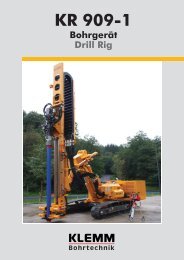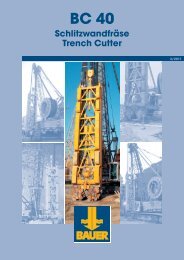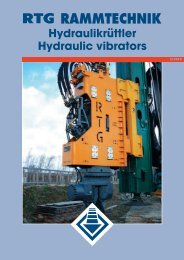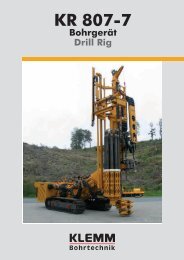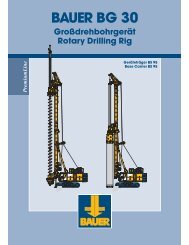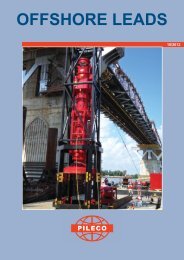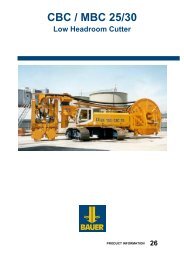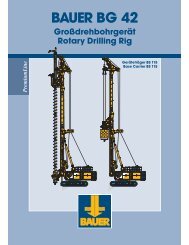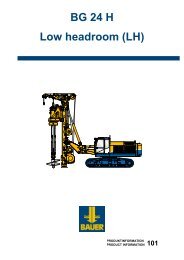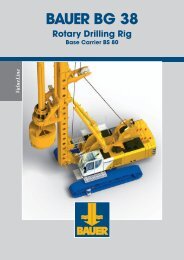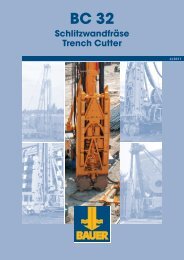Operations Manual
Download - BAUER-Pileco
Download - BAUER-Pileco
You also want an ePaper? Increase the reach of your titles
YUMPU automatically turns print PDFs into web optimized ePapers that Google loves.
A3 Summaries and calculation aids<br />
A 3.1 Terms<br />
Rated Energy<br />
The Diesel Hammers and air / steam hammers<br />
rated energy is potential energy, calculated by<br />
the ram weight times the drop height. The Diesel<br />
Hammer drop height of the ram weight depends<br />
on pile type soil and hammer condition. The<br />
maximum energy in the hammer specifications<br />
can be reached under optimum driving conditions<br />
but it is not necessarily always achievable.<br />
Hammer efficiency<br />
Is the factor or term applied to a hammer’s actual<br />
produced energy compared to it’s potential<br />
energy. Divide the kinetic energy by the potential<br />
energy to determine the hammer efficiency. The<br />
Diesel Hammer efficiency typically averages 0.8<br />
In Diesel Hammers, energy losses are typically<br />
caused by:<br />
• pre-compression, which transfers some energy<br />
into the pile<br />
• friction between ram and cylinder<br />
• impact and inertia losses of the impact block<br />
• pre-ignition, if the hammer is poorly maintained<br />
or overheated<br />
• misalignment hammer - helmet – pile<br />
Driving efficiency or transfer efficiency<br />
Is the factor or term applied to the amount of the<br />
energy put into the pile (Enthru-energy) compared<br />
to the rated energy of the hammer. The samples<br />
below show Enthru at the end of driving. Smaller<br />
steel normally show a higher transferred energy<br />
than larger ones because they are more elastic.<br />
Enthru-energy depends on the type of hammer<br />
used, size & type of pile and soil conditions.<br />
Smaller steel pipes show a higher Enthru<br />
energy compared to large and much stiffer steel<br />
piles. Concrete and timber piles show a lower<br />
transferred energy compared to steel piles.<br />
A 3.2 Correlations<br />
The correlation between the number of blows (per<br />
minute) and the drop height of the piston is shown<br />
in the diagram.<br />
The formulas below do not apply for batter piles,<br />
only for vertical piles:<br />
GRL case studies show the Enthru (transferred<br />
energy into the pile) by percentage of tested units.<br />
50 percentile of Diesel Hammers tested show<br />
35% Enthru-energy referring to rated energy. 92<br />
percentile show less than 50% Enthru-energy.<br />
111 Berry Road<br />
Houston, TX 77002<br />
Tel. (713) 691-3000<br />
Fax (713) 691-0089<br />
E-mail: info@bauerpileco.com<br />
www.bauerpileco.com<br />
<strong>Operations</strong> <strong>Manual</strong> December 2012<br />
91



